Impact of Online Stores on Shopping Behavior in Brisbane
VerifiedAdded on 2022/12/30
|14
|4159
|1
Report
AI Summary
This report investigates the significant impact of online stores on shopping behavior, focusing on the context of Brisbane, Australia. The research explores the shift from traditional retail to online platforms, analyzing consumer decision-making processes and the factors influencing online purchasing habits. The study examines the theoretical underpinnings of consumer behavior, including models like the Marshallian Economic Model, Pavlovian Learning Model, Freudian Psychoanalytical Model, Nicosia Model, and Howard-Sheth Model, to understand the motivations behind consumer choices. The report highlights the increasing use of the internet and social media in marketing and the growth of e-commerce. It also assesses trust, convenience, product variety, and privacy issues faced by online shoppers. The report emphasizes the importance of understanding consumer behavior for online marketers and retailers to design effective marketing strategies and adapt to the evolving retail landscape. The author provides personal and contextual justification for the research, noting the rapid growth of the online market and its influence on consumer behavior, emphasizing its relevance in the global market and its impact on future retail strategies.
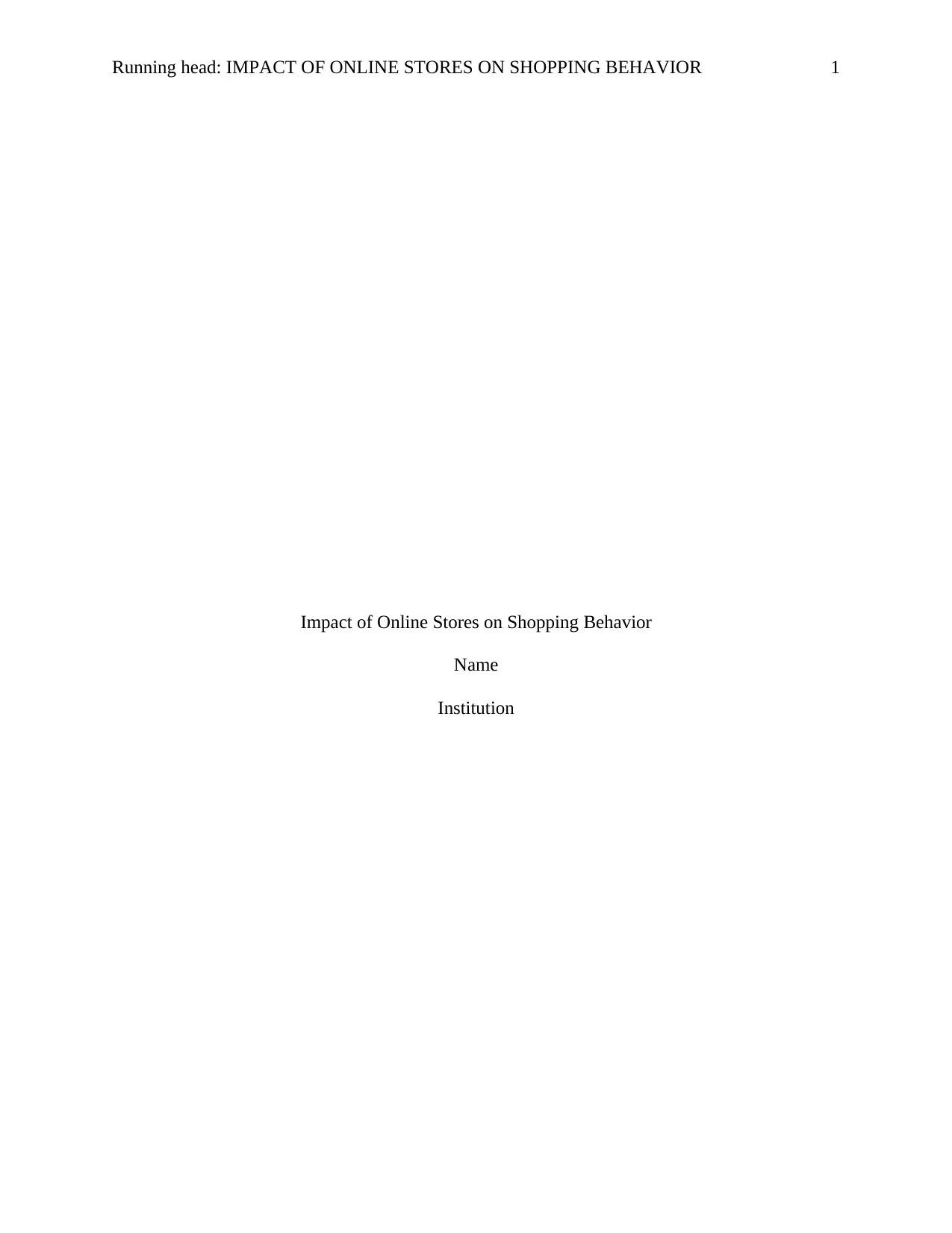
Running head: IMPACT OF ONLINE STORES ON SHOPPING BEHAVIOR 1
Impact of Online Stores on Shopping Behavior
Name
Institution
Impact of Online Stores on Shopping Behavior
Name
Institution
Paraphrase This Document
Need a fresh take? Get an instant paraphrase of this document with our AI Paraphraser
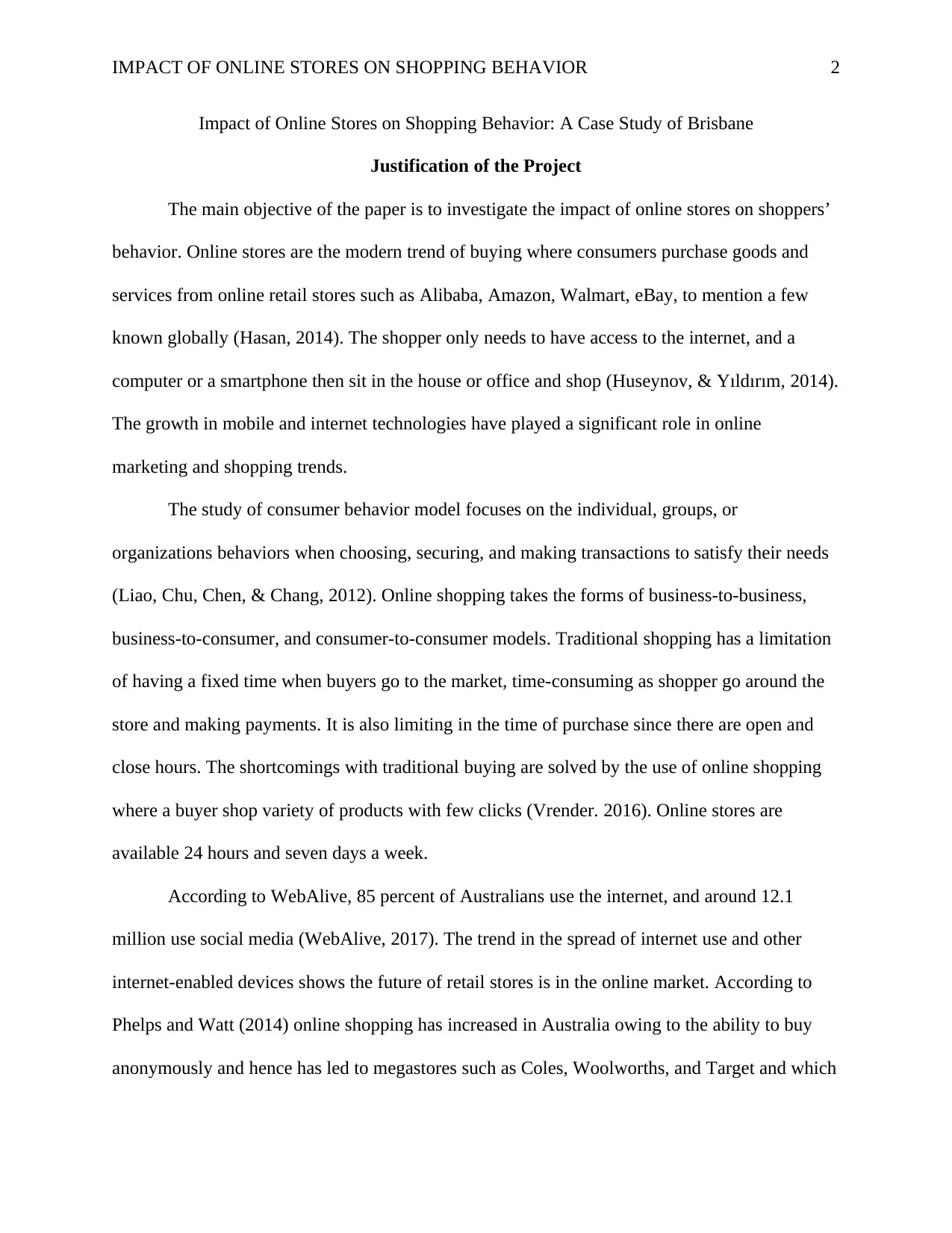
IMPACT OF ONLINE STORES ON SHOPPING BEHAVIOR 2
Impact of Online Stores on Shopping Behavior: A Case Study of Brisbane
Justification of the Project
The main objective of the paper is to investigate the impact of online stores on shoppers’
behavior. Online stores are the modern trend of buying where consumers purchase goods and
services from online retail stores such as Alibaba, Amazon, Walmart, eBay, to mention a few
known globally (Hasan, 2014). The shopper only needs to have access to the internet, and a
computer or a smartphone then sit in the house or office and shop (Huseynov, & Yıldırım, 2014).
The growth in mobile and internet technologies have played a significant role in online
marketing and shopping trends.
The study of consumer behavior model focuses on the individual, groups, or
organizations behaviors when choosing, securing, and making transactions to satisfy their needs
(Liao, Chu, Chen, & Chang, 2012). Online shopping takes the forms of business-to-business,
business-to-consumer, and consumer-to-consumer models. Traditional shopping has a limitation
of having a fixed time when buyers go to the market, time-consuming as shopper go around the
store and making payments. It is also limiting in the time of purchase since there are open and
close hours. The shortcomings with traditional buying are solved by the use of online shopping
where a buyer shop variety of products with few clicks (Vrender. 2016). Online stores are
available 24 hours and seven days a week.
According to WebAlive, 85 percent of Australians use the internet, and around 12.1
million use social media (WebAlive, 2017). The trend in the spread of internet use and other
internet-enabled devices shows the future of retail stores is in the online market. According to
Phelps and Watt (2014) online shopping has increased in Australia owing to the ability to buy
anonymously and hence has led to megastores such as Coles, Woolworths, and Target and which
Impact of Online Stores on Shopping Behavior: A Case Study of Brisbane
Justification of the Project
The main objective of the paper is to investigate the impact of online stores on shoppers’
behavior. Online stores are the modern trend of buying where consumers purchase goods and
services from online retail stores such as Alibaba, Amazon, Walmart, eBay, to mention a few
known globally (Hasan, 2014). The shopper only needs to have access to the internet, and a
computer or a smartphone then sit in the house or office and shop (Huseynov, & Yıldırım, 2014).
The growth in mobile and internet technologies have played a significant role in online
marketing and shopping trends.
The study of consumer behavior model focuses on the individual, groups, or
organizations behaviors when choosing, securing, and making transactions to satisfy their needs
(Liao, Chu, Chen, & Chang, 2012). Online shopping takes the forms of business-to-business,
business-to-consumer, and consumer-to-consumer models. Traditional shopping has a limitation
of having a fixed time when buyers go to the market, time-consuming as shopper go around the
store and making payments. It is also limiting in the time of purchase since there are open and
close hours. The shortcomings with traditional buying are solved by the use of online shopping
where a buyer shop variety of products with few clicks (Vrender. 2016). Online stores are
available 24 hours and seven days a week.
According to WebAlive, 85 percent of Australians use the internet, and around 12.1
million use social media (WebAlive, 2017). The trend in the spread of internet use and other
internet-enabled devices shows the future of retail stores is in the online market. According to
Phelps and Watt (2014) online shopping has increased in Australia owing to the ability to buy
anonymously and hence has led to megastores such as Coles, Woolworths, and Target and which
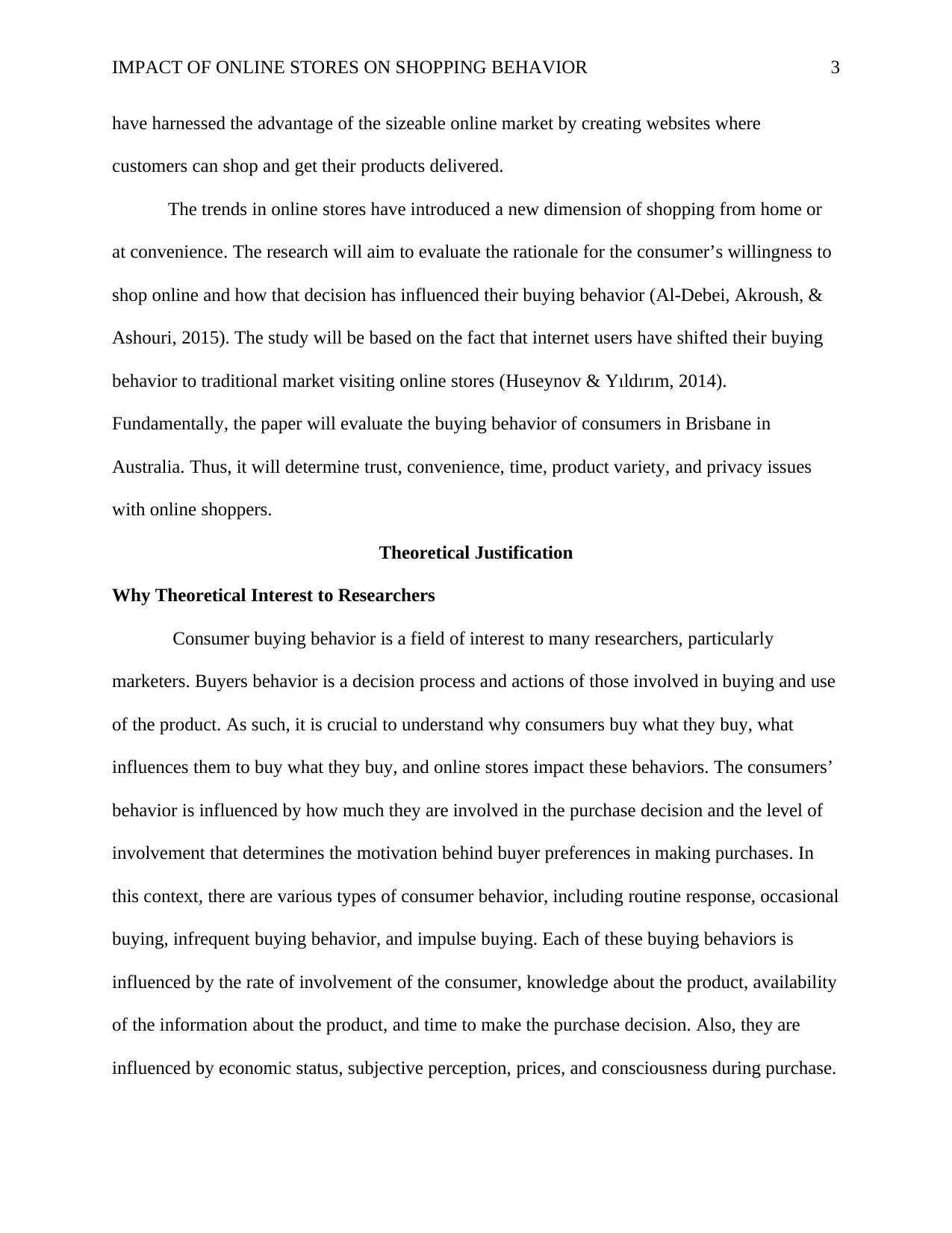
IMPACT OF ONLINE STORES ON SHOPPING BEHAVIOR 3
have harnessed the advantage of the sizeable online market by creating websites where
customers can shop and get their products delivered.
The trends in online stores have introduced a new dimension of shopping from home or
at convenience. The research will aim to evaluate the rationale for the consumer’s willingness to
shop online and how that decision has influenced their buying behavior (Al-Debei, Akroush, &
Ashouri, 2015). The study will be based on the fact that internet users have shifted their buying
behavior to traditional market visiting online stores (Huseynov & Yıldırım, 2014).
Fundamentally, the paper will evaluate the buying behavior of consumers in Brisbane in
Australia. Thus, it will determine trust, convenience, time, product variety, and privacy issues
with online shoppers.
Theoretical Justification
Why Theoretical Interest to Researchers
Consumer buying behavior is a field of interest to many researchers, particularly
marketers. Buyers behavior is a decision process and actions of those involved in buying and use
of the product. As such, it is crucial to understand why consumers buy what they buy, what
influences them to buy what they buy, and online stores impact these behaviors. The consumers’
behavior is influenced by how much they are involved in the purchase decision and the level of
involvement that determines the motivation behind buyer preferences in making purchases. In
this context, there are various types of consumer behavior, including routine response, occasional
buying, infrequent buying behavior, and impulse buying. Each of these buying behaviors is
influenced by the rate of involvement of the consumer, knowledge about the product, availability
of the information about the product, and time to make the purchase decision. Also, they are
influenced by economic status, subjective perception, prices, and consciousness during purchase.
have harnessed the advantage of the sizeable online market by creating websites where
customers can shop and get their products delivered.
The trends in online stores have introduced a new dimension of shopping from home or
at convenience. The research will aim to evaluate the rationale for the consumer’s willingness to
shop online and how that decision has influenced their buying behavior (Al-Debei, Akroush, &
Ashouri, 2015). The study will be based on the fact that internet users have shifted their buying
behavior to traditional market visiting online stores (Huseynov & Yıldırım, 2014).
Fundamentally, the paper will evaluate the buying behavior of consumers in Brisbane in
Australia. Thus, it will determine trust, convenience, time, product variety, and privacy issues
with online shoppers.
Theoretical Justification
Why Theoretical Interest to Researchers
Consumer buying behavior is a field of interest to many researchers, particularly
marketers. Buyers behavior is a decision process and actions of those involved in buying and use
of the product. As such, it is crucial to understand why consumers buy what they buy, what
influences them to buy what they buy, and online stores impact these behaviors. The consumers’
behavior is influenced by how much they are involved in the purchase decision and the level of
involvement that determines the motivation behind buyer preferences in making purchases. In
this context, there are various types of consumer behavior, including routine response, occasional
buying, infrequent buying behavior, and impulse buying. Each of these buying behaviors is
influenced by the rate of involvement of the consumer, knowledge about the product, availability
of the information about the product, and time to make the purchase decision. Also, they are
influenced by economic status, subjective perception, prices, and consciousness during purchase.
⊘ This is a preview!⊘
Do you want full access?
Subscribe today to unlock all pages.

Trusted by 1+ million students worldwide
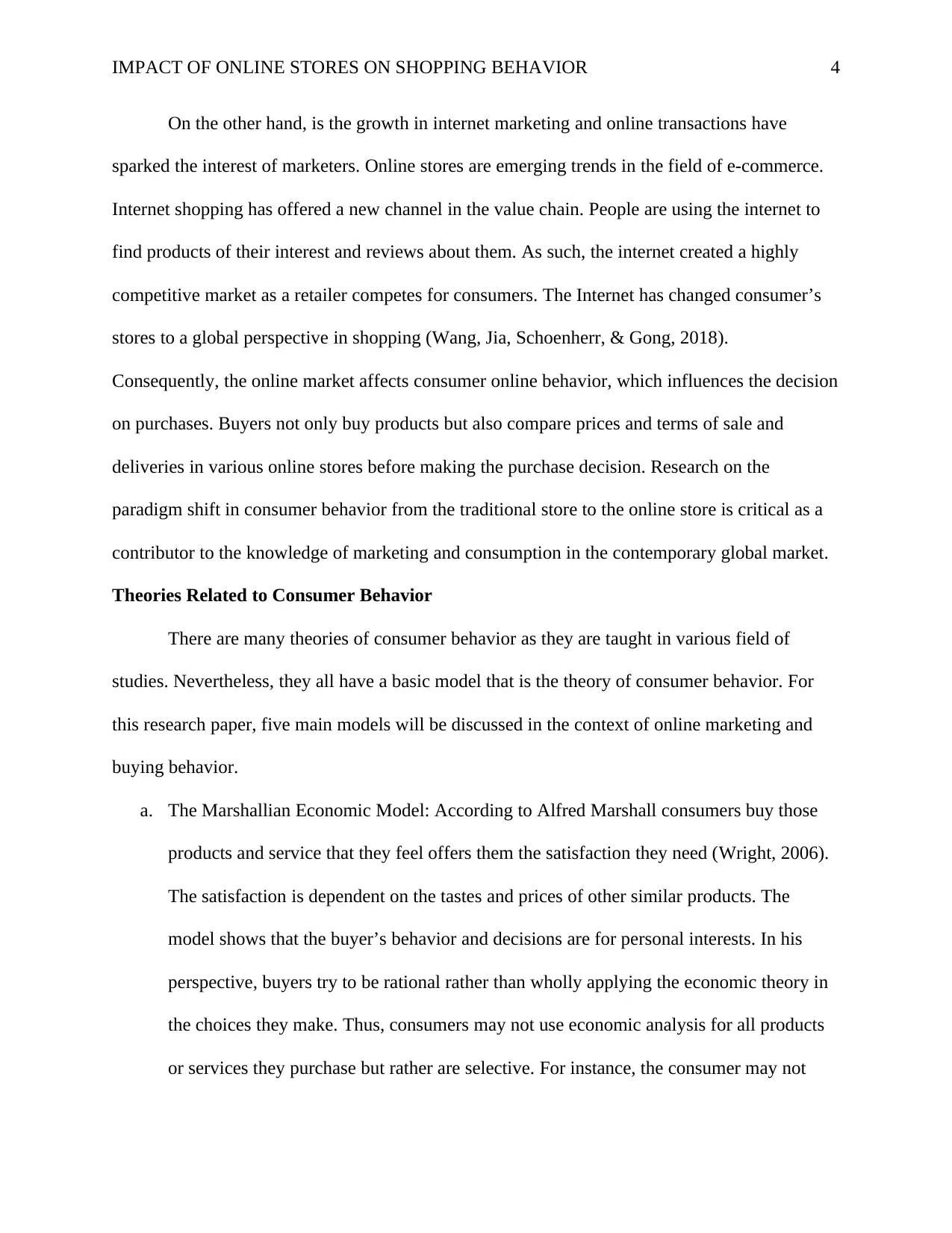
IMPACT OF ONLINE STORES ON SHOPPING BEHAVIOR 4
On the other hand, is the growth in internet marketing and online transactions have
sparked the interest of marketers. Online stores are emerging trends in the field of e-commerce.
Internet shopping has offered a new channel in the value chain. People are using the internet to
find products of their interest and reviews about them. As such, the internet created a highly
competitive market as a retailer competes for consumers. The Internet has changed consumer’s
stores to a global perspective in shopping (Wang, Jia, Schoenherr, & Gong, 2018).
Consequently, the online market affects consumer online behavior, which influences the decision
on purchases. Buyers not only buy products but also compare prices and terms of sale and
deliveries in various online stores before making the purchase decision. Research on the
paradigm shift in consumer behavior from the traditional store to the online store is critical as a
contributor to the knowledge of marketing and consumption in the contemporary global market.
Theories Related to Consumer Behavior
There are many theories of consumer behavior as they are taught in various field of
studies. Nevertheless, they all have a basic model that is the theory of consumer behavior. For
this research paper, five main models will be discussed in the context of online marketing and
buying behavior.
a. The Marshallian Economic Model: According to Alfred Marshall consumers buy those
products and service that they feel offers them the satisfaction they need (Wright, 2006).
The satisfaction is dependent on the tastes and prices of other similar products. The
model shows that the buyer’s behavior and decisions are for personal interests. In his
perspective, buyers try to be rational rather than wholly applying the economic theory in
the choices they make. Thus, consumers may not use economic analysis for all products
or services they purchase but rather are selective. For instance, the consumer may not
On the other hand, is the growth in internet marketing and online transactions have
sparked the interest of marketers. Online stores are emerging trends in the field of e-commerce.
Internet shopping has offered a new channel in the value chain. People are using the internet to
find products of their interest and reviews about them. As such, the internet created a highly
competitive market as a retailer competes for consumers. The Internet has changed consumer’s
stores to a global perspective in shopping (Wang, Jia, Schoenherr, & Gong, 2018).
Consequently, the online market affects consumer online behavior, which influences the decision
on purchases. Buyers not only buy products but also compare prices and terms of sale and
deliveries in various online stores before making the purchase decision. Research on the
paradigm shift in consumer behavior from the traditional store to the online store is critical as a
contributor to the knowledge of marketing and consumption in the contemporary global market.
Theories Related to Consumer Behavior
There are many theories of consumer behavior as they are taught in various field of
studies. Nevertheless, they all have a basic model that is the theory of consumer behavior. For
this research paper, five main models will be discussed in the context of online marketing and
buying behavior.
a. The Marshallian Economic Model: According to Alfred Marshall consumers buy those
products and service that they feel offers them the satisfaction they need (Wright, 2006).
The satisfaction is dependent on the tastes and prices of other similar products. The
model shows that the buyer’s behavior and decisions are for personal interests. In his
perspective, buyers try to be rational rather than wholly applying the economic theory in
the choices they make. Thus, consumers may not use economic analysis for all products
or services they purchase but rather are selective. For instance, the consumer may not
Paraphrase This Document
Need a fresh take? Get an instant paraphrase of this document with our AI Paraphraser
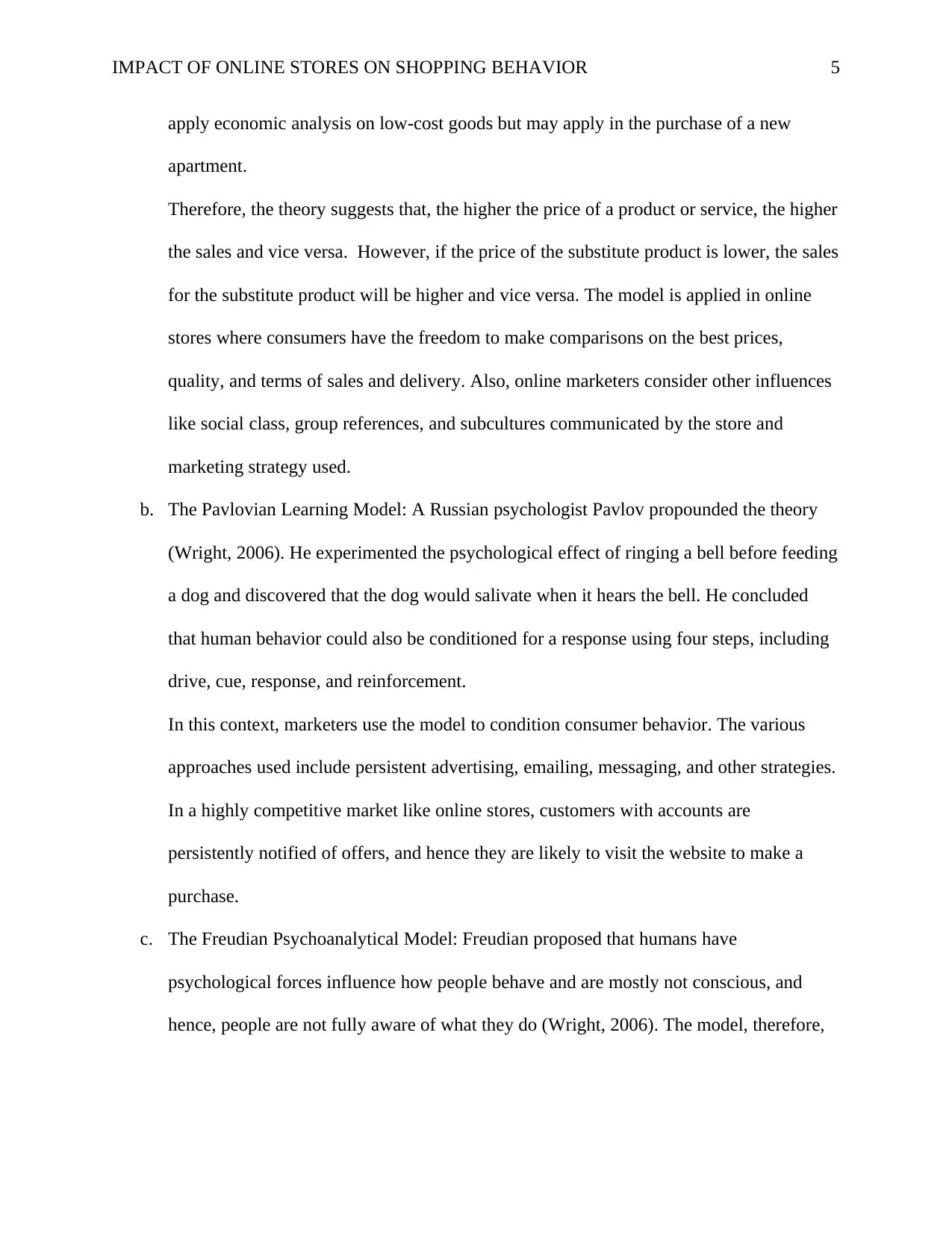
IMPACT OF ONLINE STORES ON SHOPPING BEHAVIOR 5
apply economic analysis on low-cost goods but may apply in the purchase of a new
apartment.
Therefore, the theory suggests that, the higher the price of a product or service, the higher
the sales and vice versa. However, if the price of the substitute product is lower, the sales
for the substitute product will be higher and vice versa. The model is applied in online
stores where consumers have the freedom to make comparisons on the best prices,
quality, and terms of sales and delivery. Also, online marketers consider other influences
like social class, group references, and subcultures communicated by the store and
marketing strategy used.
b. The Pavlovian Learning Model: A Russian psychologist Pavlov propounded the theory
(Wright, 2006). He experimented the psychological effect of ringing a bell before feeding
a dog and discovered that the dog would salivate when it hears the bell. He concluded
that human behavior could also be conditioned for a response using four steps, including
drive, cue, response, and reinforcement.
In this context, marketers use the model to condition consumer behavior. The various
approaches used include persistent advertising, emailing, messaging, and other strategies.
In a highly competitive market like online stores, customers with accounts are
persistently notified of offers, and hence they are likely to visit the website to make a
purchase.
c. The Freudian Psychoanalytical Model: Freudian proposed that humans have
psychological forces influence how people behave and are mostly not conscious, and
hence, people are not fully aware of what they do (Wright, 2006). The model, therefore,
apply economic analysis on low-cost goods but may apply in the purchase of a new
apartment.
Therefore, the theory suggests that, the higher the price of a product or service, the higher
the sales and vice versa. However, if the price of the substitute product is lower, the sales
for the substitute product will be higher and vice versa. The model is applied in online
stores where consumers have the freedom to make comparisons on the best prices,
quality, and terms of sales and delivery. Also, online marketers consider other influences
like social class, group references, and subcultures communicated by the store and
marketing strategy used.
b. The Pavlovian Learning Model: A Russian psychologist Pavlov propounded the theory
(Wright, 2006). He experimented the psychological effect of ringing a bell before feeding
a dog and discovered that the dog would salivate when it hears the bell. He concluded
that human behavior could also be conditioned for a response using four steps, including
drive, cue, response, and reinforcement.
In this context, marketers use the model to condition consumer behavior. The various
approaches used include persistent advertising, emailing, messaging, and other strategies.
In a highly competitive market like online stores, customers with accounts are
persistently notified of offers, and hence they are likely to visit the website to make a
purchase.
c. The Freudian Psychoanalytical Model: Freudian proposed that humans have
psychological forces influence how people behave and are mostly not conscious, and
hence, people are not fully aware of what they do (Wright, 2006). The model, therefore,
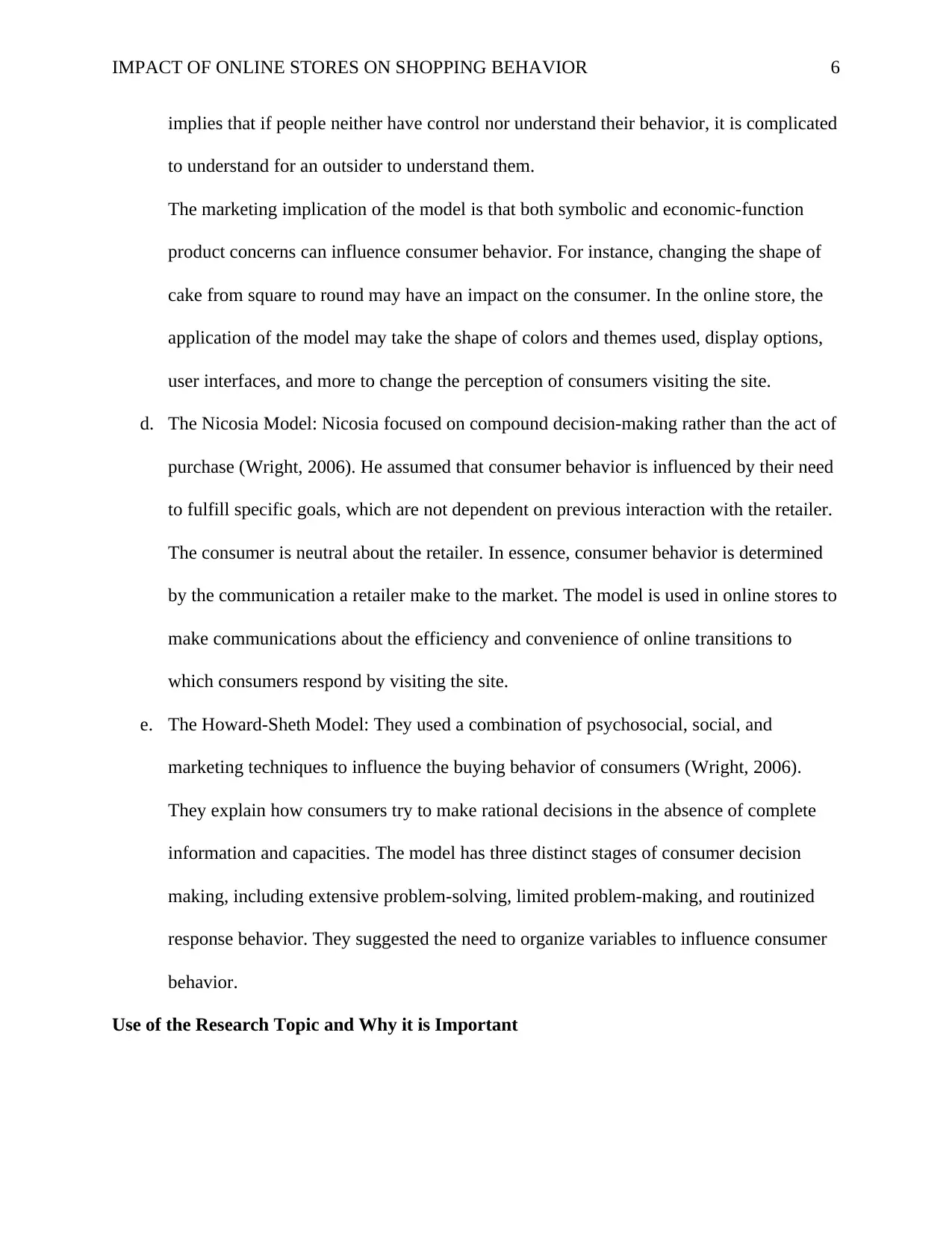
IMPACT OF ONLINE STORES ON SHOPPING BEHAVIOR 6
implies that if people neither have control nor understand their behavior, it is complicated
to understand for an outsider to understand them.
The marketing implication of the model is that both symbolic and economic-function
product concerns can influence consumer behavior. For instance, changing the shape of
cake from square to round may have an impact on the consumer. In the online store, the
application of the model may take the shape of colors and themes used, display options,
user interfaces, and more to change the perception of consumers visiting the site.
d. The Nicosia Model: Nicosia focused on compound decision-making rather than the act of
purchase (Wright, 2006). He assumed that consumer behavior is influenced by their need
to fulfill specific goals, which are not dependent on previous interaction with the retailer.
The consumer is neutral about the retailer. In essence, consumer behavior is determined
by the communication a retailer make to the market. The model is used in online stores to
make communications about the efficiency and convenience of online transitions to
which consumers respond by visiting the site.
e. The Howard-Sheth Model: They used a combination of psychosocial, social, and
marketing techniques to influence the buying behavior of consumers (Wright, 2006).
They explain how consumers try to make rational decisions in the absence of complete
information and capacities. The model has three distinct stages of consumer decision
making, including extensive problem-solving, limited problem-making, and routinized
response behavior. They suggested the need to organize variables to influence consumer
behavior.
Use of the Research Topic and Why it is Important
implies that if people neither have control nor understand their behavior, it is complicated
to understand for an outsider to understand them.
The marketing implication of the model is that both symbolic and economic-function
product concerns can influence consumer behavior. For instance, changing the shape of
cake from square to round may have an impact on the consumer. In the online store, the
application of the model may take the shape of colors and themes used, display options,
user interfaces, and more to change the perception of consumers visiting the site.
d. The Nicosia Model: Nicosia focused on compound decision-making rather than the act of
purchase (Wright, 2006). He assumed that consumer behavior is influenced by their need
to fulfill specific goals, which are not dependent on previous interaction with the retailer.
The consumer is neutral about the retailer. In essence, consumer behavior is determined
by the communication a retailer make to the market. The model is used in online stores to
make communications about the efficiency and convenience of online transitions to
which consumers respond by visiting the site.
e. The Howard-Sheth Model: They used a combination of psychosocial, social, and
marketing techniques to influence the buying behavior of consumers (Wright, 2006).
They explain how consumers try to make rational decisions in the absence of complete
information and capacities. The model has three distinct stages of consumer decision
making, including extensive problem-solving, limited problem-making, and routinized
response behavior. They suggested the need to organize variables to influence consumer
behavior.
Use of the Research Topic and Why it is Important
⊘ This is a preview!⊘
Do you want full access?
Subscribe today to unlock all pages.

Trusted by 1+ million students worldwide
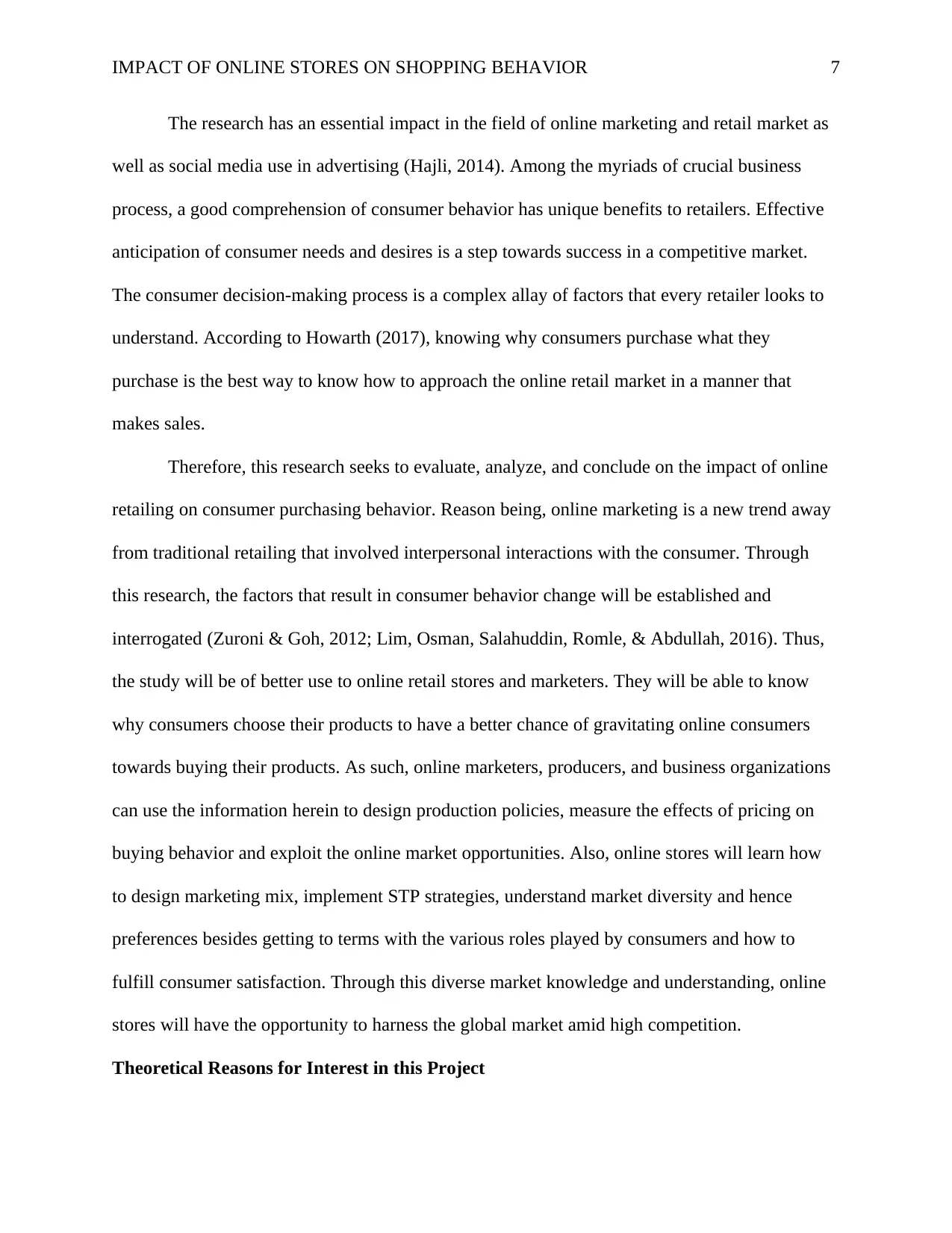
IMPACT OF ONLINE STORES ON SHOPPING BEHAVIOR 7
The research has an essential impact in the field of online marketing and retail market as
well as social media use in advertising (Hajli, 2014). Among the myriads of crucial business
process, a good comprehension of consumer behavior has unique benefits to retailers. Effective
anticipation of consumer needs and desires is a step towards success in a competitive market.
The consumer decision-making process is a complex allay of factors that every retailer looks to
understand. According to Howarth (2017), knowing why consumers purchase what they
purchase is the best way to know how to approach the online retail market in a manner that
makes sales.
Therefore, this research seeks to evaluate, analyze, and conclude on the impact of online
retailing on consumer purchasing behavior. Reason being, online marketing is a new trend away
from traditional retailing that involved interpersonal interactions with the consumer. Through
this research, the factors that result in consumer behavior change will be established and
interrogated (Zuroni & Goh, 2012; Lim, Osman, Salahuddin, Romle, & Abdullah, 2016). Thus,
the study will be of better use to online retail stores and marketers. They will be able to know
why consumers choose their products to have a better chance of gravitating online consumers
towards buying their products. As such, online marketers, producers, and business organizations
can use the information herein to design production policies, measure the effects of pricing on
buying behavior and exploit the online market opportunities. Also, online stores will learn how
to design marketing mix, implement STP strategies, understand market diversity and hence
preferences besides getting to terms with the various roles played by consumers and how to
fulfill consumer satisfaction. Through this diverse market knowledge and understanding, online
stores will have the opportunity to harness the global market amid high competition.
Theoretical Reasons for Interest in this Project
The research has an essential impact in the field of online marketing and retail market as
well as social media use in advertising (Hajli, 2014). Among the myriads of crucial business
process, a good comprehension of consumer behavior has unique benefits to retailers. Effective
anticipation of consumer needs and desires is a step towards success in a competitive market.
The consumer decision-making process is a complex allay of factors that every retailer looks to
understand. According to Howarth (2017), knowing why consumers purchase what they
purchase is the best way to know how to approach the online retail market in a manner that
makes sales.
Therefore, this research seeks to evaluate, analyze, and conclude on the impact of online
retailing on consumer purchasing behavior. Reason being, online marketing is a new trend away
from traditional retailing that involved interpersonal interactions with the consumer. Through
this research, the factors that result in consumer behavior change will be established and
interrogated (Zuroni & Goh, 2012; Lim, Osman, Salahuddin, Romle, & Abdullah, 2016). Thus,
the study will be of better use to online retail stores and marketers. They will be able to know
why consumers choose their products to have a better chance of gravitating online consumers
towards buying their products. As such, online marketers, producers, and business organizations
can use the information herein to design production policies, measure the effects of pricing on
buying behavior and exploit the online market opportunities. Also, online stores will learn how
to design marketing mix, implement STP strategies, understand market diversity and hence
preferences besides getting to terms with the various roles played by consumers and how to
fulfill consumer satisfaction. Through this diverse market knowledge and understanding, online
stores will have the opportunity to harness the global market amid high competition.
Theoretical Reasons for Interest in this Project
Paraphrase This Document
Need a fresh take? Get an instant paraphrase of this document with our AI Paraphraser
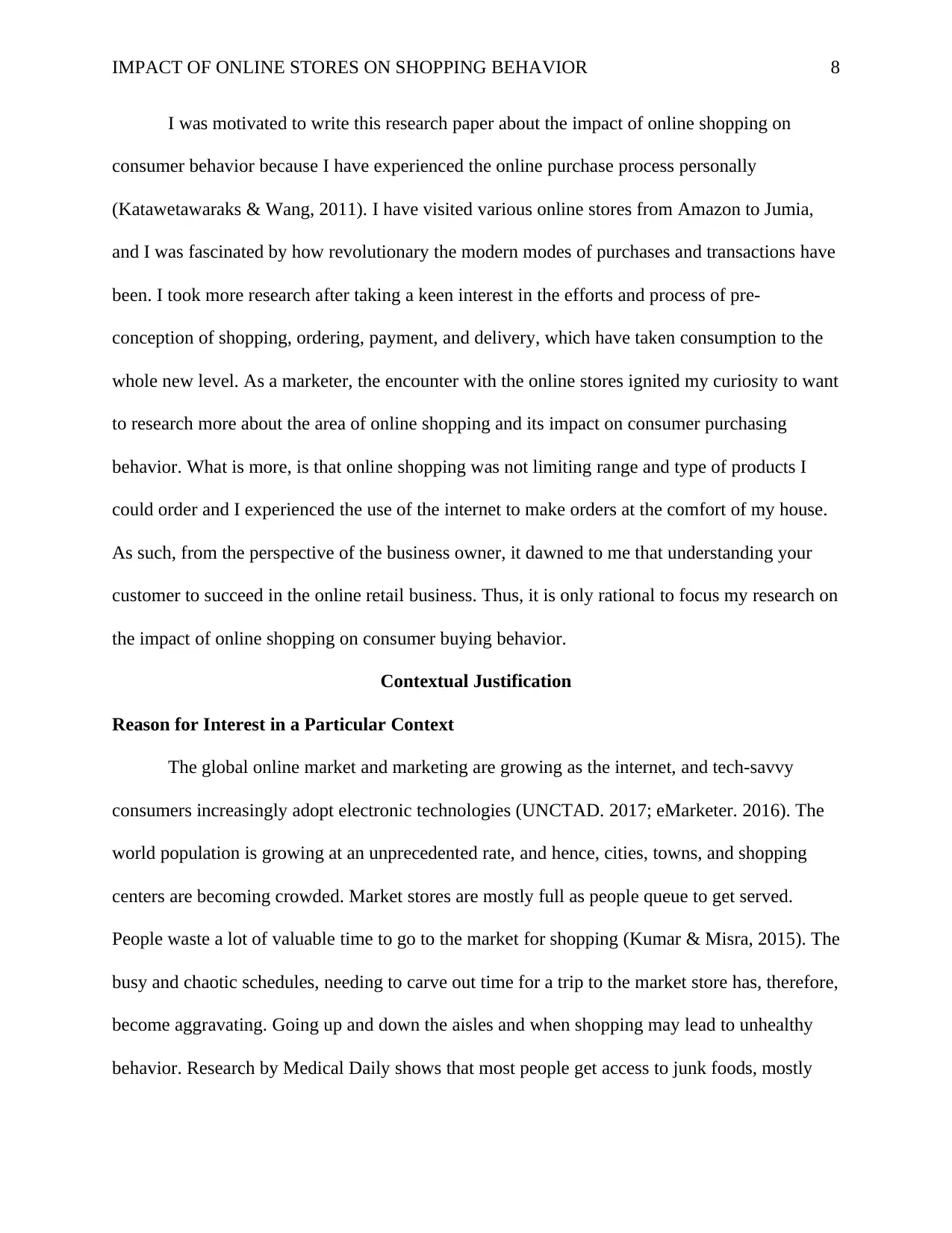
IMPACT OF ONLINE STORES ON SHOPPING BEHAVIOR 8
I was motivated to write this research paper about the impact of online shopping on
consumer behavior because I have experienced the online purchase process personally
(Katawetawaraks & Wang, 2011). I have visited various online stores from Amazon to Jumia,
and I was fascinated by how revolutionary the modern modes of purchases and transactions have
been. I took more research after taking a keen interest in the efforts and process of pre-
conception of shopping, ordering, payment, and delivery, which have taken consumption to the
whole new level. As a marketer, the encounter with the online stores ignited my curiosity to want
to research more about the area of online shopping and its impact on consumer purchasing
behavior. What is more, is that online shopping was not limiting range and type of products I
could order and I experienced the use of the internet to make orders at the comfort of my house.
As such, from the perspective of the business owner, it dawned to me that understanding your
customer to succeed in the online retail business. Thus, it is only rational to focus my research on
the impact of online shopping on consumer buying behavior.
Contextual Justification
Reason for Interest in a Particular Context
The global online market and marketing are growing as the internet, and tech-savvy
consumers increasingly adopt electronic technologies (UNCTAD. 2017; eMarketer. 2016). The
world population is growing at an unprecedented rate, and hence, cities, towns, and shopping
centers are becoming crowded. Market stores are mostly full as people queue to get served.
People waste a lot of valuable time to go to the market for shopping (Kumar & Misra, 2015). The
busy and chaotic schedules, needing to carve out time for a trip to the market store has, therefore,
become aggravating. Going up and down the aisles and when shopping may lead to unhealthy
behavior. Research by Medical Daily shows that most people get access to junk foods, mostly
I was motivated to write this research paper about the impact of online shopping on
consumer behavior because I have experienced the online purchase process personally
(Katawetawaraks & Wang, 2011). I have visited various online stores from Amazon to Jumia,
and I was fascinated by how revolutionary the modern modes of purchases and transactions have
been. I took more research after taking a keen interest in the efforts and process of pre-
conception of shopping, ordering, payment, and delivery, which have taken consumption to the
whole new level. As a marketer, the encounter with the online stores ignited my curiosity to want
to research more about the area of online shopping and its impact on consumer purchasing
behavior. What is more, is that online shopping was not limiting range and type of products I
could order and I experienced the use of the internet to make orders at the comfort of my house.
As such, from the perspective of the business owner, it dawned to me that understanding your
customer to succeed in the online retail business. Thus, it is only rational to focus my research on
the impact of online shopping on consumer buying behavior.
Contextual Justification
Reason for Interest in a Particular Context
The global online market and marketing are growing as the internet, and tech-savvy
consumers increasingly adopt electronic technologies (UNCTAD. 2017; eMarketer. 2016). The
world population is growing at an unprecedented rate, and hence, cities, towns, and shopping
centers are becoming crowded. Market stores are mostly full as people queue to get served.
People waste a lot of valuable time to go to the market for shopping (Kumar & Misra, 2015). The
busy and chaotic schedules, needing to carve out time for a trip to the market store has, therefore,
become aggravating. Going up and down the aisles and when shopping may lead to unhealthy
behavior. Research by Medical Daily shows that most people get access to junk foods, mostly
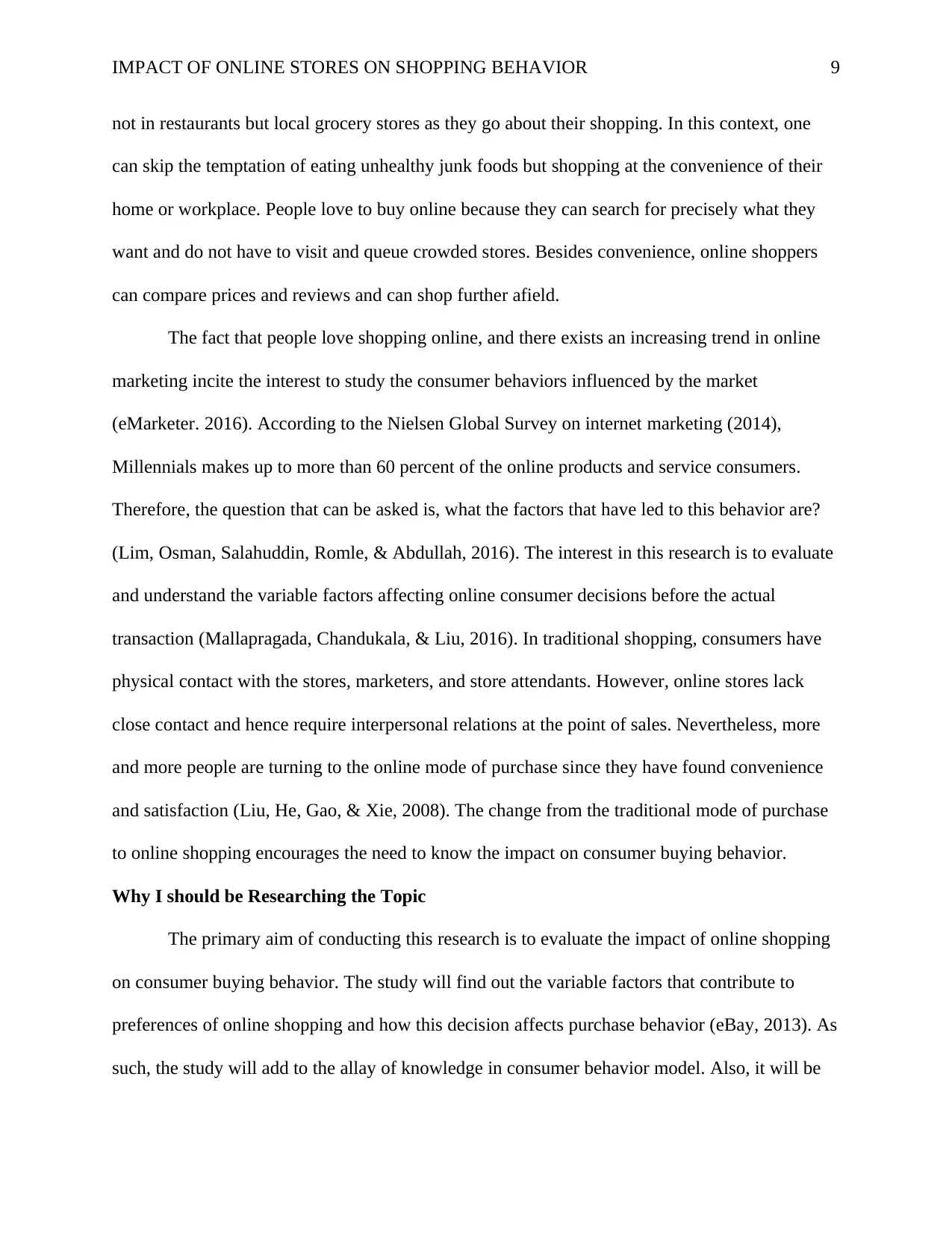
IMPACT OF ONLINE STORES ON SHOPPING BEHAVIOR 9
not in restaurants but local grocery stores as they go about their shopping. In this context, one
can skip the temptation of eating unhealthy junk foods but shopping at the convenience of their
home or workplace. People love to buy online because they can search for precisely what they
want and do not have to visit and queue crowded stores. Besides convenience, online shoppers
can compare prices and reviews and can shop further afield.
The fact that people love shopping online, and there exists an increasing trend in online
marketing incite the interest to study the consumer behaviors influenced by the market
(eMarketer. 2016). According to the Nielsen Global Survey on internet marketing (2014),
Millennials makes up to more than 60 percent of the online products and service consumers.
Therefore, the question that can be asked is, what the factors that have led to this behavior are?
(Lim, Osman, Salahuddin, Romle, & Abdullah, 2016). The interest in this research is to evaluate
and understand the variable factors affecting online consumer decisions before the actual
transaction (Mallapragada, Chandukala, & Liu, 2016). In traditional shopping, consumers have
physical contact with the stores, marketers, and store attendants. However, online stores lack
close contact and hence require interpersonal relations at the point of sales. Nevertheless, more
and more people are turning to the online mode of purchase since they have found convenience
and satisfaction (Liu, He, Gao, & Xie, 2008). The change from the traditional mode of purchase
to online shopping encourages the need to know the impact on consumer buying behavior.
Why I should be Researching the Topic
The primary aim of conducting this research is to evaluate the impact of online shopping
on consumer buying behavior. The study will find out the variable factors that contribute to
preferences of online shopping and how this decision affects purchase behavior (eBay, 2013). As
such, the study will add to the allay of knowledge in consumer behavior model. Also, it will be
not in restaurants but local grocery stores as they go about their shopping. In this context, one
can skip the temptation of eating unhealthy junk foods but shopping at the convenience of their
home or workplace. People love to buy online because they can search for precisely what they
want and do not have to visit and queue crowded stores. Besides convenience, online shoppers
can compare prices and reviews and can shop further afield.
The fact that people love shopping online, and there exists an increasing trend in online
marketing incite the interest to study the consumer behaviors influenced by the market
(eMarketer. 2016). According to the Nielsen Global Survey on internet marketing (2014),
Millennials makes up to more than 60 percent of the online products and service consumers.
Therefore, the question that can be asked is, what the factors that have led to this behavior are?
(Lim, Osman, Salahuddin, Romle, & Abdullah, 2016). The interest in this research is to evaluate
and understand the variable factors affecting online consumer decisions before the actual
transaction (Mallapragada, Chandukala, & Liu, 2016). In traditional shopping, consumers have
physical contact with the stores, marketers, and store attendants. However, online stores lack
close contact and hence require interpersonal relations at the point of sales. Nevertheless, more
and more people are turning to the online mode of purchase since they have found convenience
and satisfaction (Liu, He, Gao, & Xie, 2008). The change from the traditional mode of purchase
to online shopping encourages the need to know the impact on consumer buying behavior.
Why I should be Researching the Topic
The primary aim of conducting this research is to evaluate the impact of online shopping
on consumer buying behavior. The study will find out the variable factors that contribute to
preferences of online shopping and how this decision affects purchase behavior (eBay, 2013). As
such, the study will add to the allay of knowledge in consumer behavior model. Also, it will be
⊘ This is a preview!⊘
Do you want full access?
Subscribe today to unlock all pages.

Trusted by 1+ million students worldwide
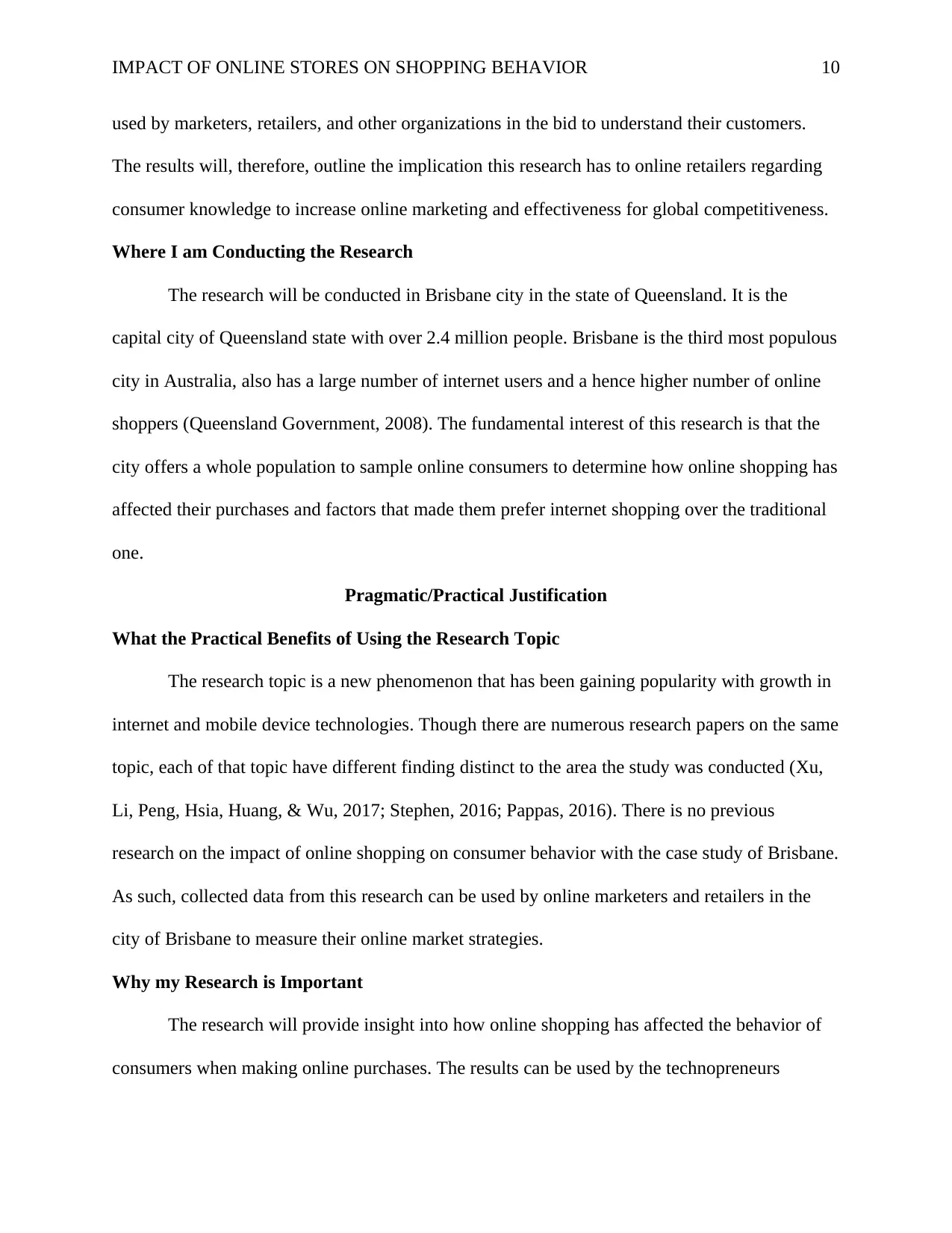
IMPACT OF ONLINE STORES ON SHOPPING BEHAVIOR 10
used by marketers, retailers, and other organizations in the bid to understand their customers.
The results will, therefore, outline the implication this research has to online retailers regarding
consumer knowledge to increase online marketing and effectiveness for global competitiveness.
Where I am Conducting the Research
The research will be conducted in Brisbane city in the state of Queensland. It is the
capital city of Queensland state with over 2.4 million people. Brisbane is the third most populous
city in Australia, also has a large number of internet users and a hence higher number of online
shoppers (Queensland Government, 2008). The fundamental interest of this research is that the
city offers a whole population to sample online consumers to determine how online shopping has
affected their purchases and factors that made them prefer internet shopping over the traditional
one.
Pragmatic/Practical Justification
What the Practical Benefits of Using the Research Topic
The research topic is a new phenomenon that has been gaining popularity with growth in
internet and mobile device technologies. Though there are numerous research papers on the same
topic, each of that topic have different finding distinct to the area the study was conducted (Xu,
Li, Peng, Hsia, Huang, & Wu, 2017; Stephen, 2016; Pappas, 2016). There is no previous
research on the impact of online shopping on consumer behavior with the case study of Brisbane.
As such, collected data from this research can be used by online marketers and retailers in the
city of Brisbane to measure their online market strategies.
Why my Research is Important
The research will provide insight into how online shopping has affected the behavior of
consumers when making online purchases. The results can be used by the technopreneurs
used by marketers, retailers, and other organizations in the bid to understand their customers.
The results will, therefore, outline the implication this research has to online retailers regarding
consumer knowledge to increase online marketing and effectiveness for global competitiveness.
Where I am Conducting the Research
The research will be conducted in Brisbane city in the state of Queensland. It is the
capital city of Queensland state with over 2.4 million people. Brisbane is the third most populous
city in Australia, also has a large number of internet users and a hence higher number of online
shoppers (Queensland Government, 2008). The fundamental interest of this research is that the
city offers a whole population to sample online consumers to determine how online shopping has
affected their purchases and factors that made them prefer internet shopping over the traditional
one.
Pragmatic/Practical Justification
What the Practical Benefits of Using the Research Topic
The research topic is a new phenomenon that has been gaining popularity with growth in
internet and mobile device technologies. Though there are numerous research papers on the same
topic, each of that topic have different finding distinct to the area the study was conducted (Xu,
Li, Peng, Hsia, Huang, & Wu, 2017; Stephen, 2016; Pappas, 2016). There is no previous
research on the impact of online shopping on consumer behavior with the case study of Brisbane.
As such, collected data from this research can be used by online marketers and retailers in the
city of Brisbane to measure their online market strategies.
Why my Research is Important
The research will provide insight into how online shopping has affected the behavior of
consumers when making online purchases. The results can be used by the technopreneurs
Paraphrase This Document
Need a fresh take? Get an instant paraphrase of this document with our AI Paraphraser
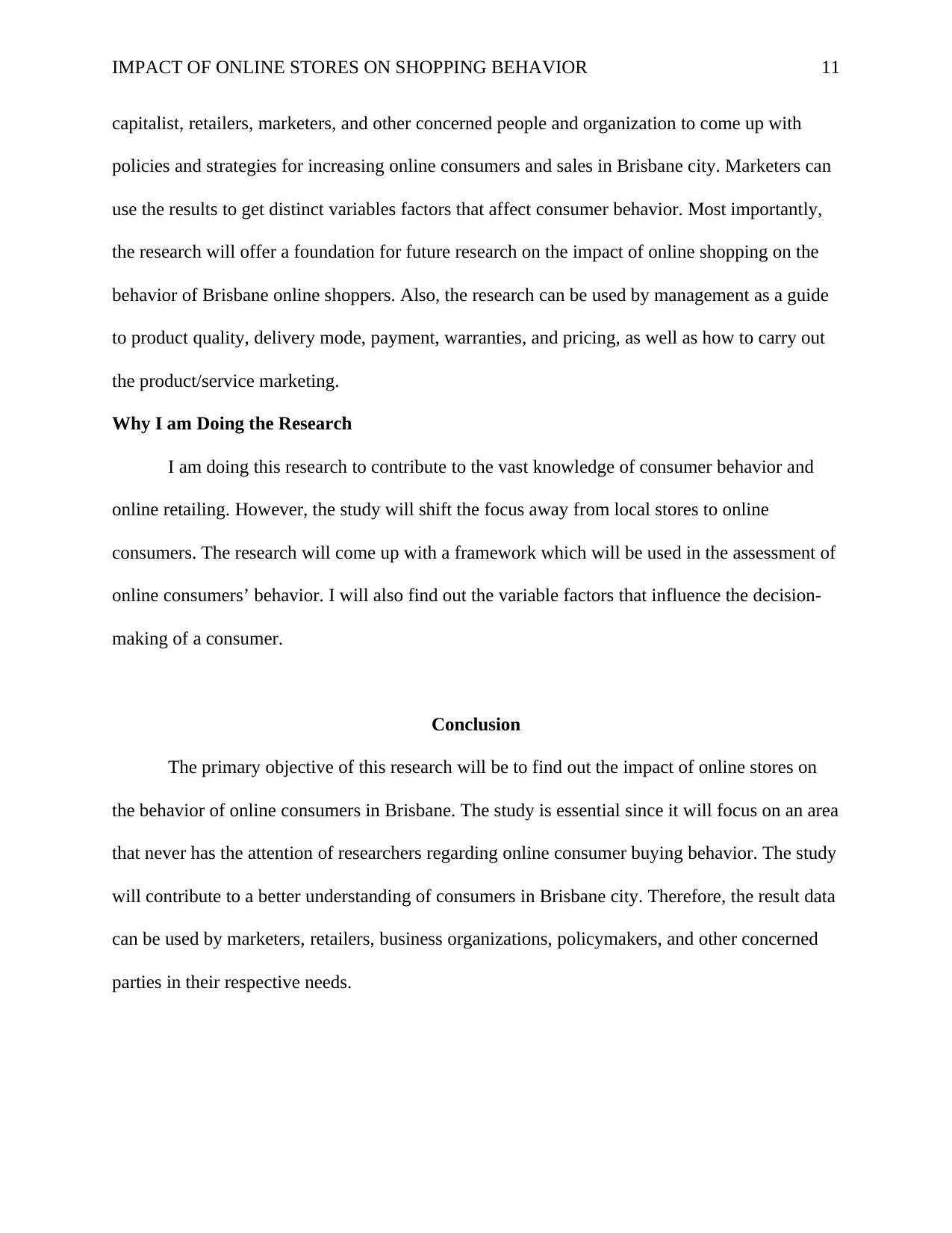
IMPACT OF ONLINE STORES ON SHOPPING BEHAVIOR 11
capitalist, retailers, marketers, and other concerned people and organization to come up with
policies and strategies for increasing online consumers and sales in Brisbane city. Marketers can
use the results to get distinct variables factors that affect consumer behavior. Most importantly,
the research will offer a foundation for future research on the impact of online shopping on the
behavior of Brisbane online shoppers. Also, the research can be used by management as a guide
to product quality, delivery mode, payment, warranties, and pricing, as well as how to carry out
the product/service marketing.
Why I am Doing the Research
I am doing this research to contribute to the vast knowledge of consumer behavior and
online retailing. However, the study will shift the focus away from local stores to online
consumers. The research will come up with a framework which will be used in the assessment of
online consumers’ behavior. I will also find out the variable factors that influence the decision-
making of a consumer.
Conclusion
The primary objective of this research will be to find out the impact of online stores on
the behavior of online consumers in Brisbane. The study is essential since it will focus on an area
that never has the attention of researchers regarding online consumer buying behavior. The study
will contribute to a better understanding of consumers in Brisbane city. Therefore, the result data
can be used by marketers, retailers, business organizations, policymakers, and other concerned
parties in their respective needs.
capitalist, retailers, marketers, and other concerned people and organization to come up with
policies and strategies for increasing online consumers and sales in Brisbane city. Marketers can
use the results to get distinct variables factors that affect consumer behavior. Most importantly,
the research will offer a foundation for future research on the impact of online shopping on the
behavior of Brisbane online shoppers. Also, the research can be used by management as a guide
to product quality, delivery mode, payment, warranties, and pricing, as well as how to carry out
the product/service marketing.
Why I am Doing the Research
I am doing this research to contribute to the vast knowledge of consumer behavior and
online retailing. However, the study will shift the focus away from local stores to online
consumers. The research will come up with a framework which will be used in the assessment of
online consumers’ behavior. I will also find out the variable factors that influence the decision-
making of a consumer.
Conclusion
The primary objective of this research will be to find out the impact of online stores on
the behavior of online consumers in Brisbane. The study is essential since it will focus on an area
that never has the attention of researchers regarding online consumer buying behavior. The study
will contribute to a better understanding of consumers in Brisbane city. Therefore, the result data
can be used by marketers, retailers, business organizations, policymakers, and other concerned
parties in their respective needs.
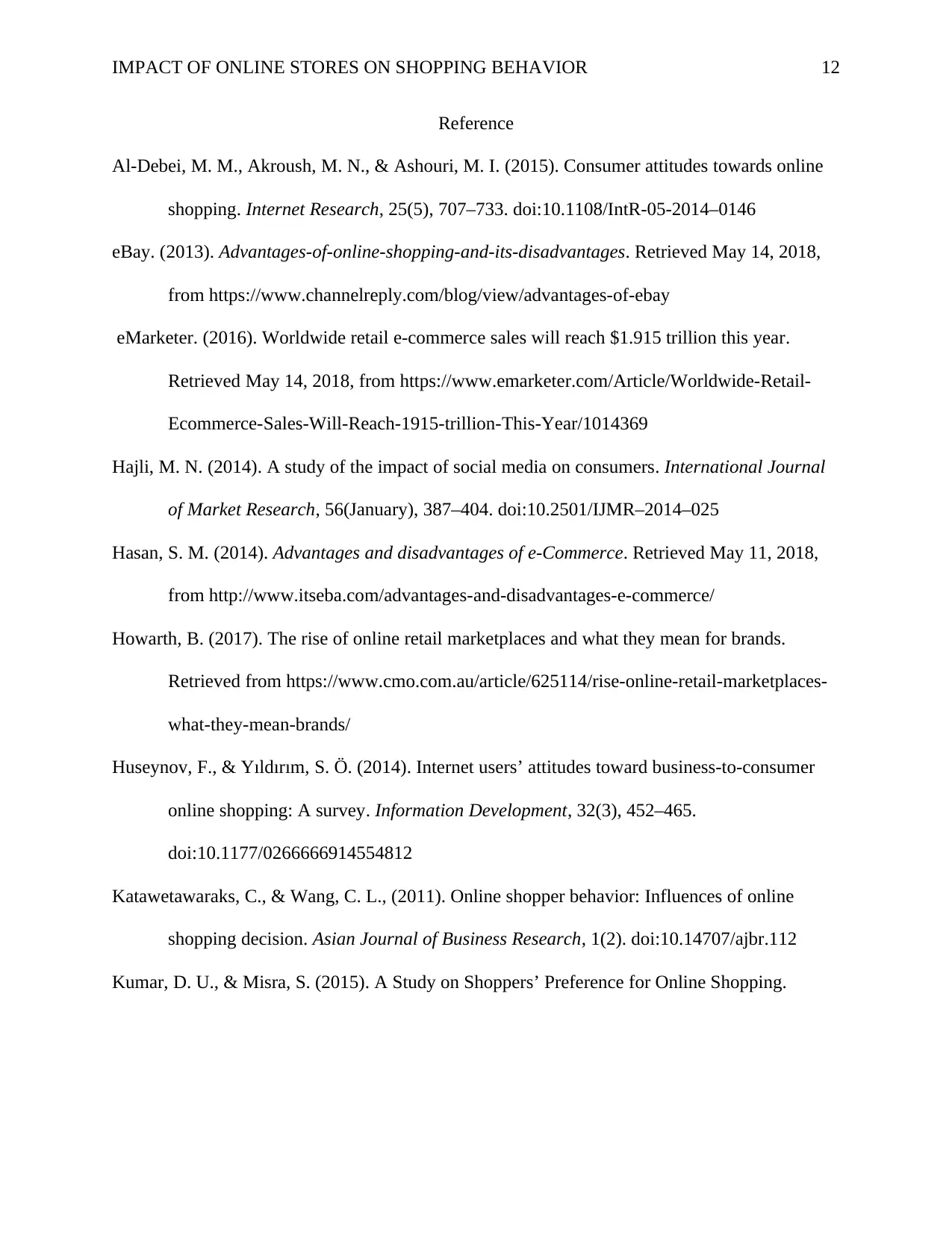
IMPACT OF ONLINE STORES ON SHOPPING BEHAVIOR 12
Reference
Al-Debei, M. M., Akroush, M. N., & Ashouri, M. I. (2015). Consumer attitudes towards online
shopping. Internet Research, 25(5), 707–733. doi:10.1108/IntR-05-2014–0146
eBay. (2013). Advantages-of-online-shopping-and-its-disadvantages. Retrieved May 14, 2018,
from https://www.channelreply.com/blog/view/advantages-of-ebay
eMarketer. (2016). Worldwide retail e-commerce sales will reach $1.915 trillion this year.
Retrieved May 14, 2018, from https://www.emarketer.com/Article/Worldwide-Retail-
Ecommerce-Sales-Will-Reach-1915-trillion-This-Year/1014369
Hajli, M. N. (2014). A study of the impact of social media on consumers. International Journal
of Market Research, 56(January), 387–404. doi:10.2501/IJMR–2014–025
Hasan, S. M. (2014). Advantages and disadvantages of e-Commerce. Retrieved May 11, 2018,
from http://www.itseba.com/advantages-and-disadvantages-e-commerce/
Howarth, B. (2017). The rise of online retail marketplaces and what they mean for brands.
Retrieved from https://www.cmo.com.au/article/625114/rise-online-retail-marketplaces-
what-they-mean-brands/
Huseynov, F., & Yıldırım, S. Ö. (2014). Internet users’ attitudes toward business-to-consumer
online shopping: A survey. Information Development, 32(3), 452–465.
doi:10.1177/0266666914554812
Katawetawaraks, C., & Wang, C. L., (2011). Online shopper behavior: Influences of online
shopping decision. Asian Journal of Business Research, 1(2). doi:10.14707/ajbr.112
Kumar, D. U., & Misra, S. (2015). A Study on Shoppers’ Preference for Online Shopping.
Reference
Al-Debei, M. M., Akroush, M. N., & Ashouri, M. I. (2015). Consumer attitudes towards online
shopping. Internet Research, 25(5), 707–733. doi:10.1108/IntR-05-2014–0146
eBay. (2013). Advantages-of-online-shopping-and-its-disadvantages. Retrieved May 14, 2018,
from https://www.channelreply.com/blog/view/advantages-of-ebay
eMarketer. (2016). Worldwide retail e-commerce sales will reach $1.915 trillion this year.
Retrieved May 14, 2018, from https://www.emarketer.com/Article/Worldwide-Retail-
Ecommerce-Sales-Will-Reach-1915-trillion-This-Year/1014369
Hajli, M. N. (2014). A study of the impact of social media on consumers. International Journal
of Market Research, 56(January), 387–404. doi:10.2501/IJMR–2014–025
Hasan, S. M. (2014). Advantages and disadvantages of e-Commerce. Retrieved May 11, 2018,
from http://www.itseba.com/advantages-and-disadvantages-e-commerce/
Howarth, B. (2017). The rise of online retail marketplaces and what they mean for brands.
Retrieved from https://www.cmo.com.au/article/625114/rise-online-retail-marketplaces-
what-they-mean-brands/
Huseynov, F., & Yıldırım, S. Ö. (2014). Internet users’ attitudes toward business-to-consumer
online shopping: A survey. Information Development, 32(3), 452–465.
doi:10.1177/0266666914554812
Katawetawaraks, C., & Wang, C. L., (2011). Online shopper behavior: Influences of online
shopping decision. Asian Journal of Business Research, 1(2). doi:10.14707/ajbr.112
Kumar, D. U., & Misra, S. (2015). A Study on Shoppers’ Preference for Online Shopping.
⊘ This is a preview!⊘
Do you want full access?
Subscribe today to unlock all pages.

Trusted by 1+ million students worldwide
1 out of 14
Related Documents
Your All-in-One AI-Powered Toolkit for Academic Success.
+13062052269
info@desklib.com
Available 24*7 on WhatsApp / Email
![[object Object]](/_next/static/media/star-bottom.7253800d.svg)
Unlock your academic potential
Copyright © 2020–2025 A2Z Services. All Rights Reserved. Developed and managed by ZUCOL.





